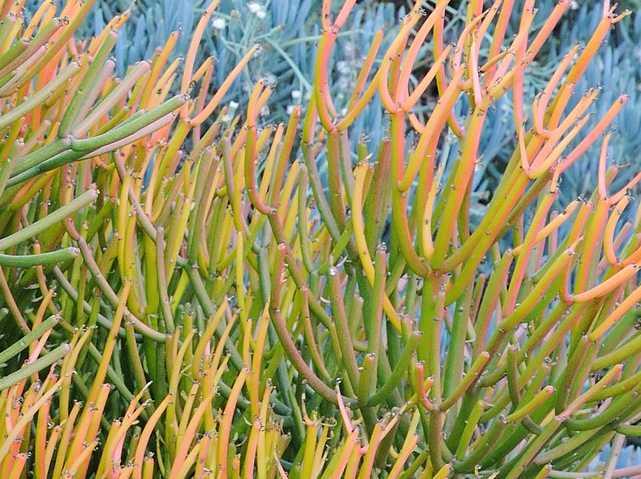Generally speaking, a Pencil Cactus (Euphorbia tirucalli) is easy to grow. You just place it in some sunny spot in your garden, in an arid soil, or a soil you got in a store for your succulents, and you can almost forget it. Or you can enjoy the beauty of the plant… Growing pencil cactus indoors, the most common problem people experience (or a most common mistake they make to say it more precisely) is over-watering, which leads to yellowing of the cactus. A much less common problem are irregular white spots of a pencil cactus, and we will look at the issue right now.
Before diving into details, let me briefly summarize the three main causes of white spots on a pencil cactus: Pests, especially mealybugs are the no. 1 reason. The second reason is mechanical damage, which can be caused by hail, storms, or even your beloved cat mistaking the cactus for a toy :). The last reason is lack of certain nutrients in the soil. Many people grow pencil cactus all around the world, and it is important to know what to do when you see the dreaded white spots. Let’s have a look at it.
Mealybugs or other pests as no. 1 reason for white spots on a pencil cactus
Pencil cactus isn’t one of the succulents that attracts a lot of pests, but in some cases it does attract them, or they may jump over to it from another infested plant you have at home. Many of these insects are super small, and unless you have very good eyes you won’t spot them without a magnifying glass. Some pests also hide during the day, and crawl out of their holes only during the night (when they feast on the cactus), and hence you again may struggle to spot them. Anyway, get a magnifying glass and inspect your cactus in different times of a day. If you notice any movements and small bugs, you have found your culprit.
What works best against bugs are either chemical pesticides from a shop (I strongly suggest you against using them though, especially on indoor cacti, since the last thing you want is to spraying such substances at your home), or homemade solutions, such as 90% alcohol, or combination of vinegar and water. There are many variations, just google it and you will find the recipe. What I want to emphasize though is that you will typically have to repeat the procedure a couple of times, and it can also happen that some bugs will survive, or their offspring will (in the form of eggs and larvae), and you’ll have to repeat the procedure all over again.
For this reason, you should think whether it wouldn’t be wiser throwing the infested pencil cactus away, together with the soil. Doing so you prevent the infestation of other plants (if they aren’t infested already), and can get rid of the bugs once and (hopefully) for good.

Mechanical damage as the no. 2 reason of white spots on a pencil cactus
If you grow your pencil cactus outside, you never know what the nature will throw at it in our era of climate change. Strong storms are ever more common, and hail may fall from the sky in almost any period of the year. Particles of hail, or even other sharp particles carried by strong wind, can easily damage your pencil cactus. Such a mechanical damage of tissues can often manifest in a form of white spots on the cactus, in the points of impact.
Other thing many people underestimate is what their cats (or other pets) can do to the plants. Cats are curious animals, and they enjoy exploring their surroundings. Pencil cactus is a funny looking plant for them, and they may start playing with it. What’s an innocent play for a cat, however, can end up deadly (or art least highly damaging) for the pencil cactus. Tissues cut with cat’s paw can easily open up and manifest as white spots on the cactus. Consider this especially if you have a cat at home (or your neighbor has one), and it has access to the plants.
Lack (or excess) of certain nutrients in the soil as the no. 3 reason for white spots on a pencil cactus
We can find many resemblances between the kingdom of plants and the kingdom of animals. For example, when we people lack Zinc or Calcium, we will have white spots on our nails. And though our organism is much more complex than the one of a pencil cactus (or any other plant for that regard), succulents also need some nutrients. If they lack some or get excess of some (for example when you over-fertilize them), they may change color, or develop white spots.
If you ruled out pests and mechanical damage, think about this one. Haven’t you fertilized the plant recently? Or haven’t you planted it in a soil intended for garden vegetables (or other type of plants), instead of soil for succulents? If you made any such changes, it can be that the pencil cactus experiences lack of some nutrients, or, on the contrary, it gets more than it needs. As a result it may develop white spots. Addressing this cause isn’t hard though. Just repot the plant to a fresh succulent soil, or stop fertilizing for some time (or completely, since pencil cactus doesn’t really need it and you are just throwing money away).
Conclusion
White spots aren’t natural for pencil cactus. As soon as you spot them, you should investigate your plant (and your actions related to it), trying to find the cause. Pests like mealybugs are the most common reason, but when you rule them out, you should consider mechanical damage, or lack/excess of certain nutrients in the soil. I hope this post helped you understand the issue, and you will soon see your pencil cactus in full beauty again 🙂
May also interest you:
